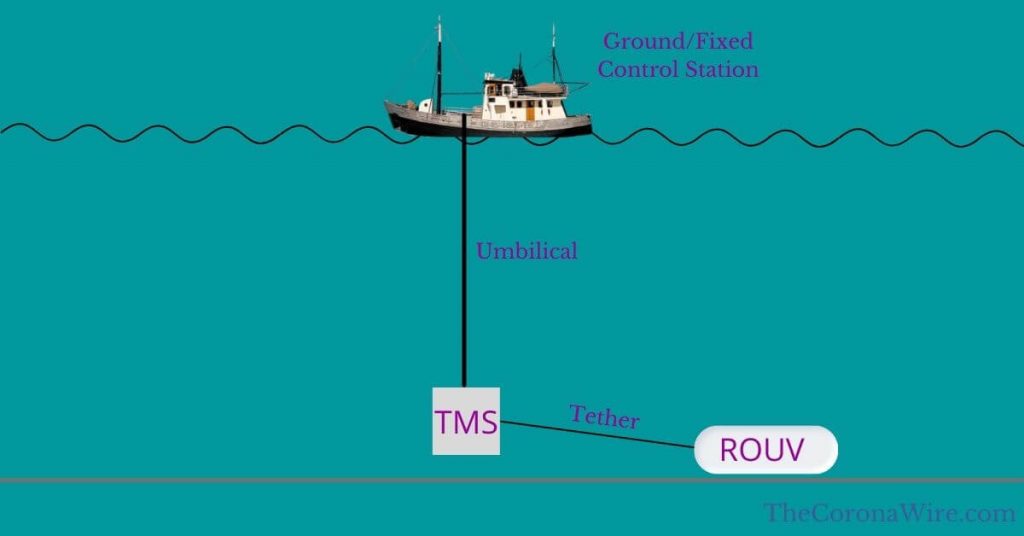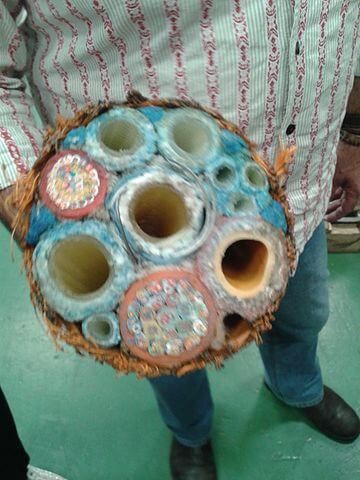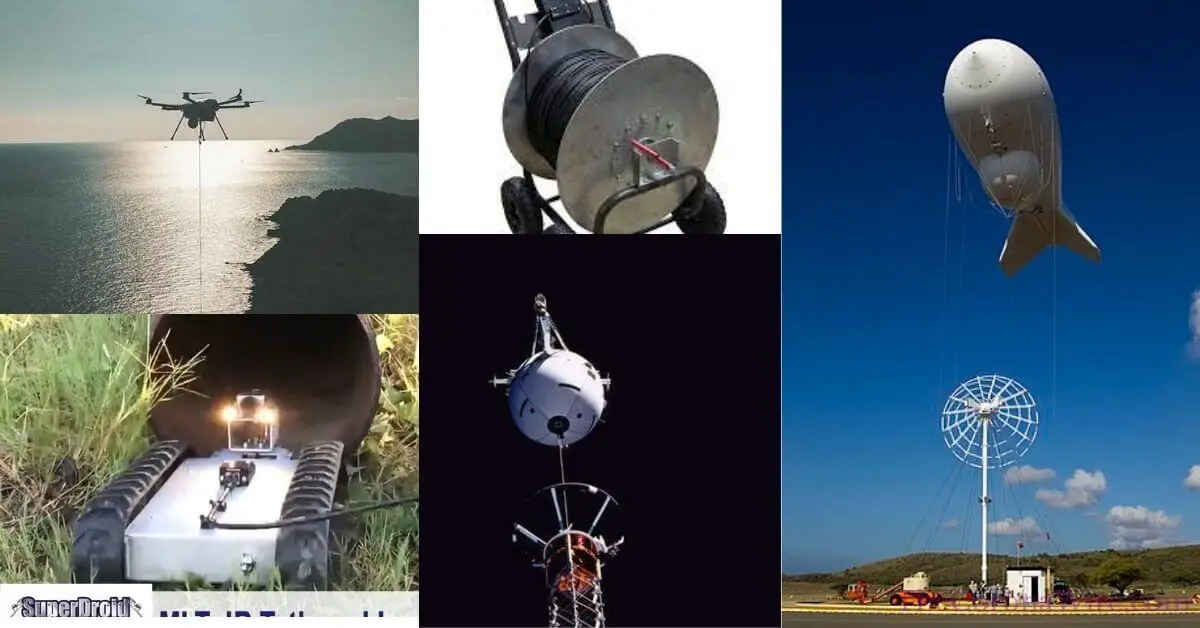Drone tethers can drastically increase a drone’s capabilities, but can also have similar negative impacts. These tethers can be used in unmanned aerial, ground, underwater, and space vehicles.
What is a drone tether and how does it work?
A drone tether is a strong or flexible (soft) cord/cable that physically connects/anchors a drone to a ground/mobile control station or other object on a boat, on land, or in space. It’s usually made up of synthetic fibres and can supply space, aerial, ground-based or underwater drones with power, and/or an anchor point for altitude/depth control and for additional stability.
In this article, we’re going to explain what drone tethers are, how they work, the types of tethers, the types of drones that use tethers, the benefits and drawbacks of drone tethers, the materials used to make them, their size, cost, laws and regulations associated with them, applications, some examples of companies that sell them and real tethered drones.
- How Drone Tethers Work and What They Do
- What Types Of Drone Tethers Are There?
- What Types Of Drones Use Tethers?
- What Are The Advantages Of Using Tethers?
- What Are The Disadvantages Of Using Tethers?
- What Materials Are Drone Tethers Made Of?
- What Size Are Drone Tethers?
- How Much Do Tethered Drones Cost?
- What Are The Laws and Regulations For Tethered UAS?
- Tethered Drone Applications
- Examples Of Tethered Drone Manufacturers/Companies
- Examples Of Tethered Drones
- Conclusion
How Drone Tethers Work and What They Do
The primary function/s of a drone tether is/are to supply the space, aerial, ground-based, or underwater drone with power, transmit data, and/or to serve as an anchor point for altitude/depth control and for additional stability.
Powered tethers usually obtain energy from a generator (power supply) that is part of the control station. The control station is used to control and receive data from the drone and to manage and convert the voltage from the generator to the drone’s required level.
The power is then sent through the tether to the drone which will have a power distribution network built within the system that splits up the total voltage to fit the needs of each electrical component in the vehicle.
Check out our post which goes into common and uncommon terminology and abbreviations used in the drone industry with individual definitions for each:
Related Post: 300+ Drone Terminology and Abbreviation Definitions Explained
Powered tethers are usually very long and can weigh a lot. This is why equipment like a tether management system (TMS) is needed.
A tether management/deployment system (TMS/TDS) is a device that lengthens and shortens the tether in order to minimise the effect of cable drag caused by wind gusts or underwater currents. It is a powered spool/cable reel that’s part of the drone’s control station.
In the case of underwater drone’s specifically, the TMS can also dive underwater to a set location and stay fixed, or it can be directly attached to the drone.
Wired transmission is much more reliable than wireless transmission as the tether always stays securely connected to the drone.
In the case of unmanned spacecraft, tethers can change the trajectory of an unmanned spacecraft such as a satellite (momentum exchange tether) and can anchor robotic spacecraft such as rovers to stationary parent robots as the child robot explores sometimes dangerous environments.
Check out our post where we explain whether a drone is a robot, what a drone and a robot actually are, some types of robots, the difference between the two, and some examples of each:
Related Post: Is A Drone Considered A Robot? Everything You Need To Know
Tethered drones have the potential of being able to operate for days on end and have actually done so in the past.
The Tethered Aerostat Radar System (TARS) 420k by Lockheed Martin is a drone (unmanned blimp) that uses a powered tether to stay in the air for 720h+ (30 days+).
The TUAS (Tethered Unmanned Aerial System) by DPI UAV Systems is a drone (Octocopter) that uses a powered tether to stay in the air for 400h+ (16 Days and 16h).
We’ve included more examples later in the article.
How do drone tethers and umbilical cables work in remotely operated underwater vehicles (ROUVs):
We’ve separated underwater drones from the rest as the components that make up the tethering system need to be specially built for the underwater environment.
Remotely operated underwater vehicles (ROUVs) either use special tethers built specifically for underwater environments which are connected to a ground/mobile control station on the surface or use a combination of an umbilical cable, tether management system (TMS), tether, and a ground/mobile control station either located on a watercraft, or on land.
The umbilical cable connects the water vessel to the tether management system (TMS), while the tether cable connects the TMS to the ROUV.

An umbilical cable/umbilical is an armoured cable and/or hose that can contain fibre optics, electric conductors and insulation, and/or an envelop protection that transports electrical, fibre optic, chemical injection, gas supply, and hydraulic connections from the operator to the TMS or any other subsea device.
An umbilical that contains multiple connections is referred to as an integrated umbilical.
These cables and devices involved in the above process also provide a drone with stabilisation, power, and depth control.
Check out our full post where we dive into several power sources currently used in drones. For each power source, we expand on how they work, the different types, the advantages, disadvantages, and real-world examples of drones that use it.
Related Post: How Are Drones Powered? 6 Drone Energy Sources Explained
Why is neutral buoyancy important for underwater tethers?
Drone tethers that have neutral buoyancy do not sink nor float. This is because the tether’s average density is equal to the water it’s in.
Normally the umbilical has a negative buoyancy due to its often high density. This is why the umbilical can be attached with buoyancy to balance it out.
What Types Of Drone Tethers Are There?
The two primary types of tethers are powered tethers and unpowered tethers. In subsea applications, umbilicals are used. In space applications, space tethers are used such as momentum exchange or electrodynamic tethers.
Powered tethers include all types of tethers and umbilicals that transport consumables from one device to another.
Unpowered tethers include all tethers that are simply used to winch and/or anchor objects without transferring anything through the cable/cord.
What Types Of Drones Use Tethers?
Drone tethers and umbilicals are used in the following types: aerial drones such as rotorcraft (single and multi-rotor), fixed-wing, hybrid VTOL, and unmanned aerostats; ground-based drones such as tracked, legged, and wheeled drones; underwater drones such as propeller-driven and underwater gliders; and unmanned spacecraft such as space probes and satellites.
There are special adapters now available that can transform untethered drones into tethered drones.
If you’d like to learn more on the different types of drones including the types according to design, payload, range, power source and use cases including some examples of both consumer, commercial and military drones, then check out our full post below:
Related Post: What Types Of Drones Are There? Every Type Of Drone Explained In Detail
What Are The Advantages Of Using Tethers?
Here are 5 advantages of drone tethers:
- They deliver continuous high-voltage power safely enabling nearly infinte operating times
- They are capable of high-bandwidth data tranfers
- They nearly completely eliminate common issues seen in wireless transmission such as radio frequency interference due to their secure and constant physical connection to the drone
- They can be designed to withstand specific environments and applications such as carrying high payloads and operating in salt water for extended periods of time
- They increase the stability, altitude and depth control of the drone they’re attached to
What Are The Disadvantages Of Using Tethers?
Here are 5 disadvantages of drone tethers:
- Tethers/umbilical cables can be hazardous if objects run into them
- Drone tethers can easily get tangled and damaged around obstacles
- Drone tethers are often heavy and take up a lot of space making them both difficult to transport and weighing down the drone which reduces operating time
- Tethers/umbilical cables can be very expensive, especially those that are packed with several connections
- Tethers/umbilical cables can be challenging to operate, especially when used in heavy winds or strong currents
What Materials Are Drone Tethers Made Of?
The materials used to create these cables are a very important feature to get right. Each cable is often custom-built for the specific application it will be used in.
Durable materials are often very heavy which will weigh down the drone. At the same time, materials that weigh less may be more prone to absorbing moisture and may not have enough protection against harsh environments causing them to wear out much sooner.
If the drone operates at high power, the cable may not be able to withstand the high temperatures generated throughout the cable.
This is why the ideal blend of materials must be found for these cables.
Most umbilical cables are steel jacketed and use thermoplastics for the connections in the inner sheath and for armour in the outer sheath.

Common thermoplastic materials used for insulation include polypropylene (PP), polyethylene (PE), and Cross-linked polyethylene (XLPE).
Most tethers are made of synthetic fibres to maintain neutral buoyancy. They use materials such as kevlar, dynema (nylon), twaron, and vectran.
The voltage/amount of power travelling through these cables can be several hundred volts.
Check out our full post that goes into detail about each component used in drones and their materials (including some examples of drones and their materials):
Related Post: What Are Drones Made Of? Detailed Guide To Drone Anatomy [Consumer+Commercial]
What Size Are Drone Tethers?
Drone tethers vary in size depending once again on the application they will be used in. Below we’ve split this up into each operating environment.
Aerial drones can use drone tethers that range in length from 40m (131.2ft) to over 100km (62.1mi) in the specific case of unmanned airships.
Underwater drones can use drone tethers that range in length from several hundred meters to over 4,000m (13,123ft) for those deepsea excursions.
If you’d like to find out a little about how deep underwater ROVs can go, whether this be consumer drones or professional drones not available to the public, then check out our post on this topic here:
Related Post: How Deep Can Underwater Drones Go? Guide To ROV Depth Capabilities
Unmanned spacecraft can use drone tethers that range in length from 10km (6.2mi) to 200km (124.3mi) in the case of momentum exchange tethers.
How Much Do Tethered Drones Cost?
Tethered unmanned aerial vehicles (UAVs) range from $15,000 to over $100,000 for more complex systems. Some tethered unmanned aerostats have been built for prices that are well over $500 million.
Tethered unmanned ground vehicles (UGVs) range from $20,000 to over $200,000 sometimes reaching several millions of dollars for high-end military UGVs.
Tethered unmanned underwater vehicles (UUVs) range from $2,000 to over $150,000.
Tethered unmanned spacecraft cost several millions of dollars to build and launch into space.
There are also a few separate tether deployment systems sold to add-on to existing drones. These include Elistair’s SAFE-T 2 and LIGH-T 4.
What Are The Laws and Regulations For Tethered UAS?
In the United States, the Federal Aviation Administration (FAA) states that tethered drones should follow the same laws as regular UAS.
In the United Kingdom, the UK Civil Aviation Authority states that tethered UAS are subject to the same basic regulations as free-flying UAS.
In Europe, the European Union Aviation Safety Agency (EASA) separates drones into three main operational categories. This includes OPEN, SPECIFIC and CERTIFIED. Tethered UAS have specific laws that are specified.
Each of these categories requires a drone, or tethered drone in this case, to meet certain requirements such as specific tether cable lengths and applications.
For more information on tethered drone laws and regulations in Europe, click here.
Tethered Drone Applications
Here are 7 tethered drone applications:
- Search and rescue
- Extending telecommunications
- Intelligence, Surveillance and Reconnaissance (ISR)
- Fixed-wing aircraft use tethers in wind tunnels for test flights
- Space propulsion and exploration
- Offshore oil and gas industry
- Mapping and survey applications
Check out our post that dives into several applications that drones have today:
Related Post: 10 Common Uses of Drones In Our Daily Lives You May Not Know About
Examples Of Tethered Drone Manufacturers/Companies
This section includes tethered drone manufacturers, tethered drone companies, and manufacturers of tethers for various applications.
Here are 7 tethered drone manufacturers/companies:
| Name | What They Sell |
| Elistair | Sells a tethered unmanned aerial vehicle and several tethering kits |
| Lockheed Martin | Sells unmanned aerial vehicles. They’ve sold several unmanned airships, some of which are tethered |
| PowerVision | Sells unmanned underwater drones. Many are tethered |
| GORE | Sells custom tether/umbilical cables |
| Clearpath Robotics | Sells unmanned ground drones. Some can be tethered with a kit |
| SEDI-ATI | Sells custom tether/umbilical cables |
| Drone Aviation Corp | Sells unmanned tethered aerostats, a tethering kit, and several tethered multi-rotor drones |
If you’d like to discover more about who the best drone companies are in the world for the consumer, commercial and military drone markets and some fun facts about them, we have a full post on this topic below:
Related Post: Top Drone Companies/Manufacturers In The World [History, What They Offer, Popular Drones And More]
Examples Of Tethered Drones
Here are 11 examples of tethered UAVs, UGVs, UUVs, and unmanned spacecraft:
| Name | Manufacturer | Design/Configuration | Operating Time | Available To General Public |
| TUAS (Tethered Unmanned Aerial System) | DPI UAV Systems | Multi-Rotor (Octocopter) | 400h+ (16 Days and 16h) | No |
| High Altitude Long Endurance Demonstrator (Hale-D) | Lockheed Martin | Unmanned Airship (Non-Rigid/Blimps) | ~504h (21 Days) | No |
| ORION 2 | Elistair | Multi-Rotor (Hexacopter) | 24h+ | Yes |
| THeMIS (Tracked Hybrid Modular Infantry System) | Milrem Robotics | UGV (Tracked) | 15h | No |
| TReX (Tethered Robotic eXplorer) | University of Toronto Institute for Aerospace Studies (UTIAS) | UGV (4 Wheels) | 8h+ | No |
| SST2 | Superdroid Robots | UGV (Tracked) | 2h | Yes |
| Gladius mini | Chasing | UUV (Propeller-Driven) | 2h | Yes |
| PowerRay | PowerVision | UUV (Propeller-Driven) | 4h | Yes |
| BlueROV2 | Blue Robotics | UUV (Propeller-Driven) | ~4h | Yes |
| DuAxel | NASA | Unmanned Spacecraft (Rover) | ? | No |
| Tethered Satellite System (TSS-1) | NASA+Italian Space Agency (ASI) | Unmanned Spacecraft (Artificial Satellite) | ? | No |
Conclusion
Drone tethers bring many benefits to all types of drones in all operating environments. Drone operators will however need to sacrifice some features for the benefits mentioned.
These tethering systems will be more beneficial to drones used in specific applications. The difference in benefits and drawbacks will need to be weighed by those planning to use these types of drones.
However, there is no doubt that tethered systems have enabled drones to accomplish incredible feats, and will continue to expand their capabilities in the near future.
Sources:
